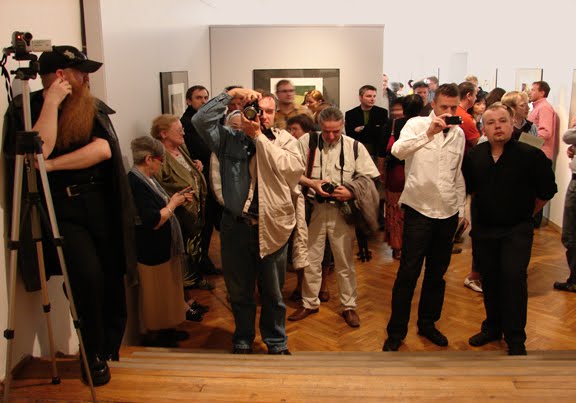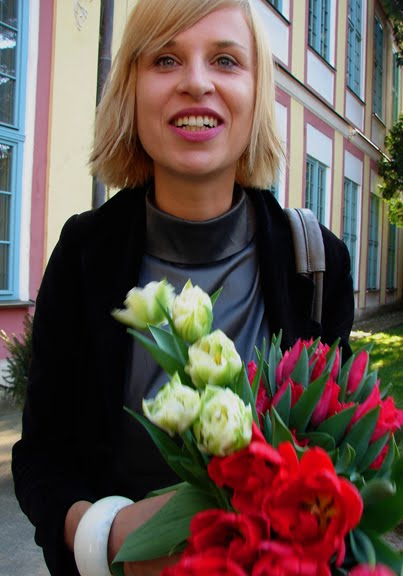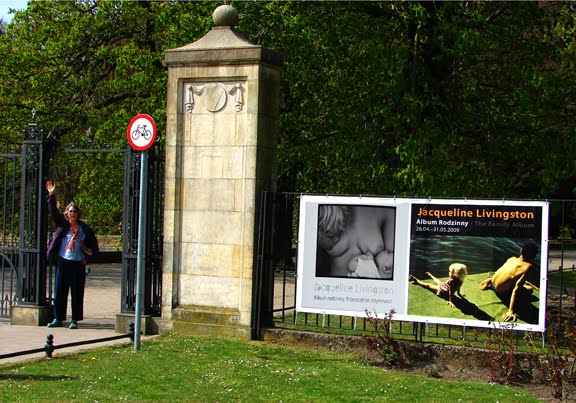@2009 by Jacqueline Livingston
In 1976, my second year at Cornell University as an Assistant Professor of Photography, I exhibited a few photographs of male nudes, including one of my six-year-old son, Sam playing with himself. My life quickly changed. I was called into the dean’s office and told to remove my photographs from the exhibition because complaints had been filed; some were worried that children might see them. I refused to remove my photographs and argued in their defense, “My photographs were meant to challenge a sexually repressed culture, to open its eyes to the beauty of the male nude and the beauty of a child raised to be comfortable with nudity, owning his own body. Who better to see these photographs than children?”
A month later I was told my contract would not be renewed. In speaking to the art department chair, I was told bluntly, “You cannot be a feminist and stay at Cornell and furthermore, you cannot photograph male genitalia and expect to stay here either.”
I had moved across country from San Francisco to Ithaca for this job. My marriage had ended; I had my child to support. Another move at this point seemed out of the question. After months of bargaining with Cornell, I threatened a sex-discrimination suit. Within one week, a one-year, nonrenewable contract arrived. At the end of that year (June 1978) when Cornell still did not provide reasons in writing for denying me further employment, I filed a sex-discrimination suit against the university with the Human Rights Commission of New York State.
In the fall of 1980, four other plaintiffs and I entered court with a class action sex-discrimination suit against Cornell. During the five years of litigation, thirty-six other women, ex-Cornell faculty, joined the suit. Cornell settled out of court for $250,000--$16,000 each for the five original plaintiffs. It was hardly a year’s academic salary.
In October of 1979, I refinanced my home and published a series of fourteen posters (each 18 x 24 inches) containing over 200 photographic images of three generations of men. My son Sam, my husband Richard, and my father-in-law John are introduced on the first poster. Four separate posters for each of them follow, telling the story of each character (a total of twelve posters). The series ends with the final (fourteenth poster) showing the three males together again. The two men are shown letting the boy experience his freedom and supporting him as well.
In the first poster showing the three generations, each of the males is shown in a sequence of four photos. Running down the left of the poster, Sam is first seen nude with his back to the camera, a boy of six, wearing a wig, lying on a bed with a rose-covered sheet. As the series progress, Sam looks over his shoulder at me (his photographer-mother) and says with his facial expression, “What are you up to? What’s with the wig? You want people to think I’m a girl?” In the last frame, he flips over, spreads his legs, showing full frontal nudity with a grin from ear to ear, as if to say, “Hey! I am a boy! Take a look.” The series has the title, “Sam on a Bed of Roses.”
Running down the middle of this first poster are the four photos that introduce John. He is at a beach, dressed in a suit holding up a ten foot long, three to four inch in diameter piece of seaweed that resembles a snake. John appears to be charming it and then cuts the seaweed into foot long lengths and buries them standing upright in the sand. The phallic symbolism is unmistakable.
On the far right of this first poster are four photos of Richard. He is dressed in a suit, sitting in a large office chair with his briefcase on the desk in front of him. The image of Konan the Barbarian is glued to the front side of the briefcase. He lets out an enormous scream, leaves the office and his briefcase behind.
Moving on to the second poster, we see the first in the series of four posters about Sam. He is a boy of six who has just moved from posing nude on the bed (where we found him introduced in the first poster) to posing nude on the sofa. He is still full of mischief, joking around. The camera moves in for close-ups of him playing with himself, unselfconscious. (This was the series of nine photos first exhibited at Cornell in 1976.)
In the second poster about Sam, he is eight and playing in the bathtub with a phallic-shaped balloon that he clearly recognized as such. He has fun pretending it is a gun and his penis, putting it between his legs, bending it, sucking it as a breast, hugging, squeezing, bouncing it—his toy.
In the third poster about Sam, he is ten and nude in the first frame, then frame by frame (through a series of nine) he adds a piece of clothing until finally, with a bit of wishful thinking, he puts on his father’s suit coat. Its oversize arms nearly cover his hands, only the ends of his fingertips show.
In the fourth and final poster about Sam, he is holding a cardboard cut-out of a suit coat nearly the size of his father’s coat in real life. It is covered with a collage of stereotypical male-role-icons representing cultural expectations. Sam takes the collaged coat to a cemetery, buries it, and leaves with its reverse shadow, a white cardboard cut-out of a suit coat, symbolic of a clean slate on which he can create his own future.
In the photographic posters about Sam’s father and grandfather, each man starts out clothed and gets undressed (symbolically freeing themselves from cultural duress) in the process of transformation. In a series of ten photos, they make strained gestures and attempts at touching.
I sent a set of these 14 posters to a total of 300 museums, galleries, critics, and artists, asking them to hang the posters in whatever venue they could during the month of October 1979. This was a way to confront and bypass art-establishment practices that in essence censor (potentially) controversial work. Some of my peers in academe showed and discussed the posters in their art classes. At one school a professor attempted a public exhibition of the entire set only to be foiled by the school’s president. The professor rented a space off-campus at his own expense and advertised. Hundreds lined up to see the show, and all four local TV stations reported the event.
On October 8, 1979, the Village Voice printed an interview with me by Howard Smith. They published three of the posters, including the one of Sam playing with himself. I received over 400 letters of congratulation and support from around the country, surprisingly only one was condemning, and sold nearly 100 sets. The negative side soon arrived. Howard Smith called saying, “Hide your posters. The American Society for the Prevention of Cruelty to Children is pounding at our door, threatening legal action against the Voice. They are calling your photos ‘kiddie porn.’ Their lawyers are talking to ours. If they bring charges, they could confiscate your work.”
Then someone called the child abuse hotline about me. A letter from New York Child Protective Services informed me that I was under investigation for suspected child abuse; my character and fitness as a parent were questioned. I had to hire a lawyer. He got me a copy of New York State’s pornography law. I felt relieved that it seemed to allow for artistic merit and intent, and didn’t automatically label all nudes “obscene.” I was under the impression that my art was under the protection of the First Amendment. With this assurance, my then eleven-year-old son and I met with a social worker who questioned us with our lawyer present. My son was asked how he felt about the photographs of him (“Fine we’re nudist.”), and I was asked, “Are you photographing other children nude?” (“No.”)
The social worker had seen my fourteen posters in the local gallery in a feminist bookstore and said he supported my work. According to him, I was fortunate to have him assigned to my case; anyone else would have given me a hard time. Four months later, I received a letter declaring the accusations “unfounded.” That was one of the happiest days of my life.
[Flashback:] Months before the Voice publication, I’d photographed Sam nude in a friend’s New York City loft. Sam stood next to a brass birdcage almost as tall as him with a beautiful parrot. As I always did with slide film, I mailed it to be processed at Kodak in Rochester. It seemed to be taking a long time. I finally heard from Kodak. They were holding eight rolls of my film and giving me the choice of allowing them to destroy the film or turn it over to the district attorney.
My lawyer advised me that I let Kodak destroy my film because the district attorney was up for reelection and had already created a name for himself by “successfully” prosecuting seven “porn” cases. He was almost certain to prosecute me, so I felt I had no choice but to succumb; and Kodak destroyed my film.
With no teaching position on the horizon, I realized that the controversial nature of my photography might mean my demise in academe. So I was forced to find a new career. I began investing in real estate. In 1982-83, with the help of my future husband Leo, I opened “Jacqueline Livingston—A One Artist Gallery” in New York’s Soho. I exhibited my photography with a different show monthly and displayed the fourteen posters of my family throughout the year I was open.
As soon as I opened, the FBI showed up. They sent a powerful looking man nearly weekly to confront and harass me face-to-face; later his visits tapered off to monthly. Each confrontation was the same; he’d ask, “How are you able to get away with your exhibition of kiddie porn?” I felt protected by the First Amendment and said so. I explained that not every nude picture of a child is pornography and that my photography was art, it had a message. And it was owned by major art museums. (The fourteen posters were already then collected by The Metropolitan Museum in New York, and the Museum of Modern Art in New York and in San Francisco, plus several others.)
The $100,000 the gallery project cost was much more than I’d anticipated. To maintain it I had to sell and refinance some of my newly acquired real estate. From that point on, I had to work mostly at menial jobs that left me exhausted. There was no extra time or energy to realize my most ambitious photographic ideas or to edit, promote, and exhibit the photographs that I did make.
I continued applying for academic jobs, but it was hopeless. I never stopped photographing, but I simply could not find the time and energy to give voice to my images by writing autobiographical texts to accompany them or to produce a book of my photography. I no longer saw myself as the triumphant veteran of censorship. I began to think it was my fault that I was silent and submerged.
I received some vindication for my work in 1999 when the Herbert F. Johnson Museum of Art at Cornell University presented the exhibition “Children Seen and Not Heard” and included my poster of Sam in the bathtub, playing with the phallic-shaped balloon. The show’s catalogue describes how exhibiting the photos of my son at Cornell cost me my teaching position there, explains that I believe in “bringing up children liberally and openly addressing their sexuality,” describes the poster and continues by saying, that “Ultimately, it is undeniable that this child is having fun playing and it the [sic] only the adults who find this problematic.”
Tuesday, October 20, 2009
Subscribe to:
Post Comments (Atom)





No comments:
Post a Comment